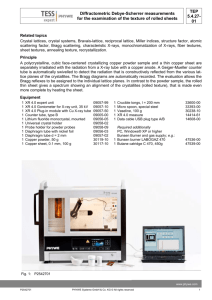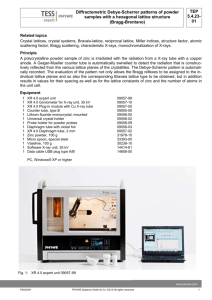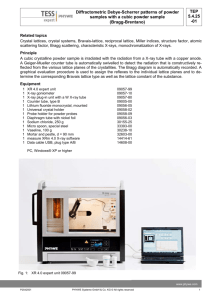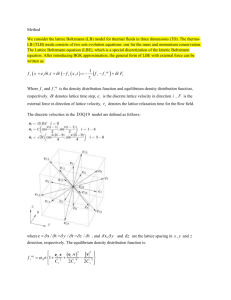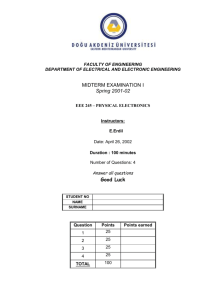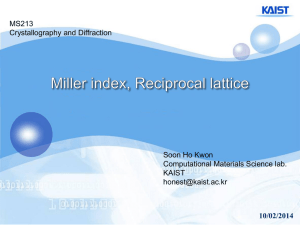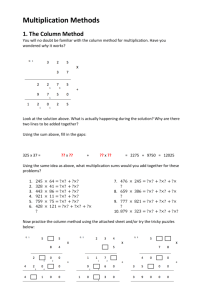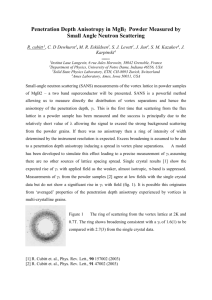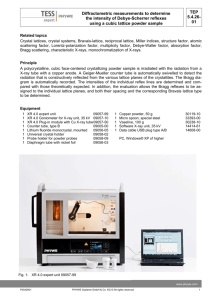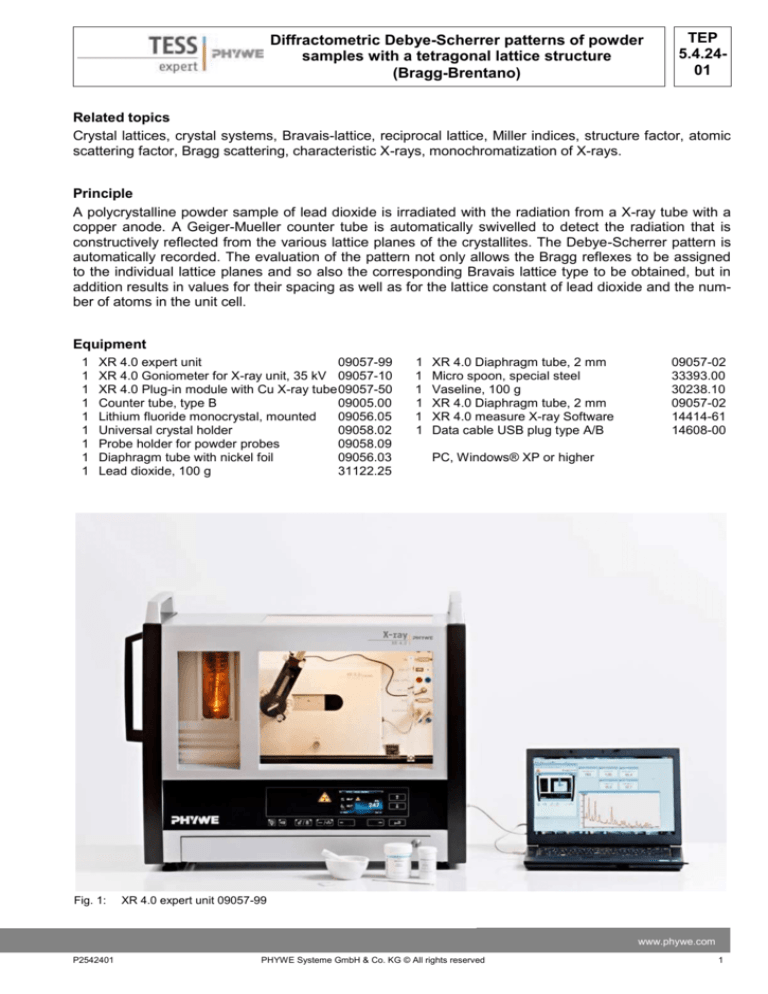
Diffractometric Debye-Scherrer patterns of powder
samples with a tetragonal lattice structure
(Bragg-Brentano)
TEP
5.4.2401
Related topics
Crystal lattices, crystal systems, Bravais-lattice, reciprocal lattice, Miller indices, structure factor, atomic
scattering factor, Bragg scattering, characteristic X-rays, monochromatization of X-rays.
Principle
A polycrystalline powder sample of lead dioxide is irradiated with the radiation from a X-ray tube with a
copper anode. A Geiger-Mueller counter tube is automatically swivelled to detect the radiation that is
constructively reflected from the various lattice planes of the crystallites. The Debye-Scherrer pattern is
automatically recorded. The evaluation of the pattern not only allows the Bragg reflexes to be assigned
to the individual lattice planes and so also the corresponding Bravais lattice type to be obtained, but in
addition results in values for their spacing as well as for the lattice constant of lead dioxide and the number of atoms in the unit cell.
Equipment
1
1
1
1
1
1
1
1
1
XR 4.0 expert unit
09057-99
XR 4.0 Goniometer for X-ray unit, 35 kV 09057-10
XR 4.0 Plug-in module with Cu X-ray tube 09057-50
Counter tube, type B
09005.00
Lithium fluoride monocrystal, mounted
09056.05
Universal crystal holder
09058.02
Probe holder for powder probes
09058.09
Diaphragm tube with nickel foil
09056.03
Lead dioxide, 100 g
31122.25
Fig. 1:
1
1
1
1
1
1
XR 4.0 Diaphragm tube, 2 mm
Micro spoon, special steel
Vaseline, 100 g
XR 4.0 Diaphragm tube, 2 mm
XR 4.0 measure X-ray Software
Data cable USB plug type A/B
09057-02
33393.00
30238.10
09057-02
14414-61
14608-00
PC, Windows® XP or higher
XR 4.0 expert unit 09057-99
www.phywe.com
P2542401
PHYWE Systeme GmbH & Co. KG © All rights reserved
1
TEP
5.4.2401
Diffractometric Debye-Scherrer patterns of powder
samples with a tetragonal lattice structure
(Bragg-Brentano)
Tasks
1. Record the intensity of the Cu X-rays back scattered by a lead dioxide powder sample as a function
of the scattering angle.
2. Calculate the lattice constant of the substance from the angular positions of the individual Bragg lines.
3. Assign the Bragg reflexes to the respective planes of the
lead dioxide lattice and determine which Bravais lattice type
it has.
4. Determine the number of atoms in the unit cell.
Set-up
Connect the goniometer and the Geiger-Müller counter tube to
their respective sockets in the experiment chamber (see the red
markings in Fig. 2). The goniometer block with the analyser crystal should be located at the end position on the left-hand side.
Fasten the Geiger-Müller counter tube with its holder to the back
stop of the guide rails. Do not forget to install the diaphragm in
front of the counter tube.
Insert a diaphragm tube with a diameter of 2 mm into the beam
outlet of the tube plug-in unit.
Note
Fig. 2: Connectors in the experiment
Details concerning the operation of the X-ray unit and goniome- chamber
ter as well as information on how to handle the monocrystals
can be found in the respective operating instructions.
Holder for Powder
samples and universal crystal holder
Counter
tube diaphragm
GM-counter
tube
diaphragm tube
d = 2 mm
Goniometer at the
left end position
Fig. 3: Set-up of the goniometer
2
PHYWE Systeme GmbH & Co. KG © All rights reserved
P2542401
Diffractometric Debye-Scherrer patterns of powder
samples with a tetragonal lattice structure
(Bragg-Brentano)
TEP
5.4.2401
Procedure
- Connect the X-ray unit via the USB cable to the
USB port of your computer (the correct port of
the X-ray unit is marked in Figure 4).
- Start the “measure” program. A virtual X-ray unit
will be displayed on the screen.
- You can control the X-ray unit by clicking the
various features on and under the virtual X-ray
Fig. 4: Connection of the computer
unit. Alternatively, you can also change the parameters at the real X-ray unit. The program will
automatically adopt the settings.
- Click the experiment chamber (see the red
marking in Figure 5) to change the parameters
for the experiment. Select the parameters as
shown in the text box.
- If you click the X-ray tube (see the red marking
in Figure 5), you can change the voltage and
current of the X-ray tube. Select the parameters
as shown in the text box: Anode voltage UA = 35
kV; anode current IA = 1 mA..
- Start the measurement by clicking the red circle:
-
After the measurement, the following window
appears:
For setting the
X-ray tube
For setting the
goniometer
Fig. 5: Part of the user interface of the software
-
-
Select the first item and confirm by clicking OK.
The measured values will now be transferred
directly to the “measure” software.
At the end of this manual, you will find a brief
introduction to the evaluation of the resulting
spectra.
Note
- Never expose the Geiger-Müller counter tube
to the primary X-radiation for an extended period of time.
Overview of the settings of the goniometer and
X-ray unit:
- 1:2 coupling mode
- angle step width 0.1°
- Scanning range 10°-45°
- Anode voltage UA = 35 kV; anode current
IA = 1 mA
- Scanning speed, when only the very intense
reflex lines are to be recorded, then scanning can be relatively rapid at 10 s/°. For the
identification of weaker lines, a scanning
speed of at least 40 s/° is required for a better signal/noise ratio
www.phywe.com
P2542401
PHYWE Systeme GmbH & Co. KG © All rights reserved
3
TEP
5.4.2401
Diffractometric Debye-Scherrer patterns of powder
samples with a tetragonal lattice structure
(Bragg-Brentano)
Sample preparation
Transfer a little of the lead dioxide powder onto a sheet of paper, add a little vaseline and use a spatula
to knead the mixture to a firm paste. To achieve the highest concentration of material as possible, use
very little vaseline (a spatula tip of it). Fill the relatively solid paste into the specimen for powder samples
and smooth it flush. Use the universal crystal holder to hold the specimen.
Calibration of the goniometer with the LiF single-crystal:
Exact angular positions of Debye-Scherrer reflections are only to be expected when the goniometer is
correctly adjusted. Should the goniometer be out of adjustment for any reason whatever, this fault can be
corrected either manually or by means of the autocalibration function:
- Automatic calibration:
The anode material of the X-ray tube is automatically identified. The crystal must be manually set under “Menu”, “Goniometer”, “Parameter”. For calibration, select “Menu”, “Goniometer”, “Autocalibration”. The device now determines the optimal positions of the crystal and the goniometer to each other
and then the positions of the peaks. The display shows the corresponding calibration curves. The
newly configurated zero position of the goniometer system is saved even after switch-off of the X-ray
unit.
- Manual calibration
The crystal for analysis must be manually brought to the theoretical Bragg angle ϑ (counter tube correspondingly to 2ϑ). Now search for the intensity maximum of the line by iterative turning of the crystal
and counter tube by a few ±1/10° around this angular position. Following this and in coupled mode,
bring the crystal and counter tube to the particular zero position corrected by the error value and then
confirm with “Menu”, “Goniometer” and “Set to zero”.
Theory and Evaluation
When X-rays of wavelength λ strike a mass of lattice planes of a crystal of spacing d at a glancing angle
of ϑ, then the reflected rays will only be subject to constructive interference when Bragg’s condition is fulfilled, i.e.:
2d sin n ;
n 1,2,3,...
(1)
When there is only one atom a unit cell, then all reflexes that occur fulfill Bragg’s conditions. When there
are N atoms in a unit cell, however, then the total amplitude of the X-rays scattered by the cell is described by the structure factor F, which is calculated by summing up the atomic scattering factors f of
each individual atom of the N atoms, taking their phases into account.
The following is generally valid for F:
N
Fhkl f n e 2i hun kvn hwn
(2)
1
where h, k, l = Miller indices of the reflecting lattice planes and un, vn, wn are the coordinates of the atoms
in fractions of the particular edge lengths of the unit cell. As F is in general a complex number, the total
scattered intensity is described by |Fhkl|2.
The unit cell of a tetragonal system can be simple, i.e. have only one atom at the lattice origin. Further to
this, various face-centered variants, or also body-centered unit cells, can occur. Only the latter, which
contains two atoms/molecules at the coordinates 0,0,0 and ½, ½, ½, will be considered here. According
to equation (2), therefore, the structure factor F for this lattice type is given by:
F f e 2i 0 e 2i 1 / 2 h1 / 2k 1 / 2l
(3)
It follows from this that, when h + k + l = 2n + 1, then n = 1, 2, 3, 4.. (i.e. the sum is odd), so F = 0.
4
PHYWE Systeme GmbH & Co. KG © All rights reserved
P2542401
Diffractometric Debye-Scherrer patterns of powder
samples with a tetragonal lattice structure
(Bragg-Brentano)
TEP
5.4.2401
If h + k + l = 2n (i.e. the sum is even), however, then F = 2f and |Fhkl|2 = 4f 2.
For a tetragonal crystal system, the spacing d of the individual lattice planes with the indices (hkl) is obtained from the quadratic form:
h2 k 2 l 2
1
2 (a, c = lattice constants)
2
2
d hkl
a
c
(4)
From this and equation (1) with n = 1, the quadratic Bragg equation is obtained:
sin
2
1
2 3
4
2 h 2 k 2 l 2
4
a2
c2
5
6
7
8 9
↓ ↓ ↓ ↓ ↓
↓
↓ ↓↓
(5)
10 11 12 13
↓↓↓ ↓
14
15
16 17
↓
↓
↓↓
18 19
↓↓
Fig. 6: Debye-Scherrer Cu-Kα and Cu-Kβ–lines of lead dioxide (PbO2)
www.phywe.com
P2542401
PHYWE Systeme GmbH & Co. KG © All rights reserved
5
TEP
5.4.2401
Diffractometric Debye-Scherrer patterns of powder
samples with a tetragonal lattice structure
(Bragg-Brentano)
Task 1
Fig. 6 shows the Debye-Scherrer spectrum of a powder sample of lead dioxide (PbO2).
As no filter is used for the monochromatization of the X-rays in Fig. 6, the fact that the very intense lines
resulting from Kα-radiation are accompanied by secondary lines resulting from the weaker Kβ radiation
must be taken into consideration when individual lines are evaluated.
Such pairs of lines can be identified by means of equation (1). It is namely approximately true with λ(Kα)
= 154.18 pm and λ(Kβ) = 139.22 that:
K sin 154,18 pm
1,1
K sin 139,22 pm
(6)
This value corresponds with the quotients of the sin2
values (Table 3) of the pairs of lines 2-1, 4-3, 7-6,
showing that lines 1, 3 and 6 originate from the Cu Kβ
radiation.
The correctness of this conclusion can be shown by a
control measurement (see Fig. 7) using the diaphragm tube with nickel foil to reduce the intensity of
the Kβ radiation. The reflexes in Fig. 6 that were previously assigned to the Kβ lines are no longer to be
seen. As the intensity of the Kα- radiation is also
somewhat weakened by the Ni foil, the detection of
reflexes of weak intensity at larger glancing angles is
made difficult when this is used.
1
4 5
7
↓ ↓↓
↓
8
↓
10
11
15
12
13
16
14
17
Task 2 and 3:
For the evaluation of the spectrum in Fig. 6, equation
Fig. 7: Debye-Scherrer diagram of PbO2 only with Cu(5) is rearranged as follows:
Kα beam (a nickel filter was used here)
sin 2 A h 2 k 2 Bl 2 mit A
B
2
2
4a 2
und
(7)
4c 2
The value of A is determined solely by the hk lines. With l = 0, it follows from equation (7) that:
sin 2 A h 2 k 2
(8)
The possible values for (h2 + k2) are 1, 2, 4, 5, 8, 9, 10.....(see Table 1).
Table 1: Possible h, k combinations
10
11
hk
2
2
1
2
h +k
20
4
21
5
22
8
30
9
31
10
On dividing the sin2ϑ values by 2, 4, 5, 8, ... (Table 2) and searching for quotients that are equal to each
other, or to a sin2ϑ value, it can be assumed that these belong to the hk lines.
6
PHYWE Systeme GmbH & Co. KG © All rights reserved
P2542401
Diffractometric Debye-Scherrer patterns of powder
samples with a tetragonal lattice structure
(Bragg-Brentano)
TEP
5.4.2401
Only the first lines need be examined here, as these always belong to the low indexed lattice planes.
The analysis of the values in Table 2 reveals a difficulty. It shows, namely, that two pairs of numbers (in
italics and bold face) come into question for further analysis. As the difference between the bold face
values is lower, however, these should be used as a basis for further consideration.
On calculating the mean value of the bold face values of lines 2 and 5, A = 0.024145 is obtained.
Table 2: Evaluation of the Kα- lines for the determination of lattice constant a
ϑ/°
Line
2
4
5
7
12,69
16,01
18,11
24,59
sinϑ
0,21968
0,27580
0,31084
0,41612
sin2ϑ
0,04826
0,07607
0,09662
0,17316
sin2ϑ/2
0,02413
0,03803
0,04831
0,08658
sin2ϑ/4
0,01206
0,01902
0,02416
0,04329
sin2ϑ/5
0,00965
0,01521
0,03462
0,03885
sin2ϑ/8
0,00603
0,00951
0,01208
0,02165
hkl
110
200
Using this value for A and λ (Kα) = 154.18 pm, it follows from equation (7) that for the first lattice constant: a = 496.1 pm. Should the assumption that has been made be correct, then line 2 must be given
the index 110 and line 5 the index 200. A, 2A, 4A, 5A, 8A etc. is now subtracted from the sin2ϑ values
(see Table 3) and a search made for Bl2 values that are in a ratio to each other of 1, 4, 9, 16 etc..
A first look at Table 3 appears to show that this is fulfilled by the values in italics for the lines 2, 5, 8 and
10.
Table 3: Evaluation of the Kα- lines for the determination of lattice constant c and assignment of the reflexes to the lattice planes.
Line
sinϑ
1(β)
2
3(β)
4
5
6(β)
7
8
9
10
11
12
13
14
15
16
17
18
19
11,44
12,69
14,41
16,03
18,13
22,07
24,59
26,15
27,12
29,49
30,36
31,29
33,45
37,27
39,29
42,09
42,89
44,06
44,60
sin2ϑ
sin2ϑ-A
sin2ϑ2A
0,04826
0,02412
0,07625
0,09683
0,05211
0,07268
0,04854
0,17316
0,19424
0,20780
0,24233
0,25546
0,26975
0,30383
0,36672
0,40100
0,44493
0,46321
0,48360
0,49302
0,14902
0,17001
0,17437
0,21819
0,23132
0,24561
0,27968
0,34256
0,37686
0,42515
043906
0,45946
0,46888
0,12487
0,14595
0,15022
0,19404
0,20717
0,22146
0,25554
0,31843
0,35271
0,40101
0,41492
0,43531
0,44473
sin2ϑ4A
0,07658
0,09766
0,10193
0,14575
0,15888
0,17317
0,20725
0,27014
0,30442
0,35272
0,36663
0,38702
0,39644
sin2ϑ5A
0,05243
0,07252
0,07778
0,12161
0,13444
0,14093
0,18311
0,24599
0,28027
0,32858
0,34248
0,36289
0,37230
sin2ϑ8A
0,04917
0,06230
0,07659
0,11003
0,17356
0,20784
0,24984
0,27005
0,29044
0,29986
hkl
sin2ϑ
Δ
110
0,04829
0,00030
101/011
200/020
0,07641
0,09658
0,00016
-0,00025
211/121
220
002
310/130
112
301/031
202/022
321/231
222
312/132
411/141
420/240
310/130
0,17300
0,19316
0,20908
0,24145
0,25737
0,26958
0,30566
0,36615
0,40224
0,45053
0,46273
0,48290
0,49457
-0,00016
-0,00108
0,00128
-0,00088
0,00191
-0,00017
0,00183
-0,00057
0,00124
0,00560
-0,00048
-0,00070
0,00155
Because the following is true:
½(0.19424+0.19404) / ½(0.04826+0.04857) ≈ 4.
This gives B = 0.048431 and, acc. to equation (6), c = 350.4 pm. With the values so determined for a
and c, and using equation (9), the number of atoms in the unit cell is calculated to be n ≈ 2.
Lines 2 and 5 would have the indices 111 and 201, i.e. odd and mixed indexed reflexes occur. This is in
contradiction to the number of atoms/molecules in the unit cell. Two atoms/molecules per unit cell signifies a body-centered lattice, with which the only reflexes that should occur are those for which h + k + l =
www.phywe.com
P2542401
PHYWE Systeme GmbH & Co. KG © All rights reserved
7
TEP
5.4.2401
Diffractometric Debye-Scherrer patterns of powder
samples with a tetragonal lattice structure
(Bragg-Brentano)
2n is valid.
The approach made above must therefore be rejected.
Now taking the bold type values for lines 4, 7, 11, 13 and 15, we obtain:
⅓ (0.20717+0.20725+0.20784) / ½ (0.05211+0.05243) = 3.97 ≈ 4.
This results in a mean value for
B = ½ (0.05211 + 0.05243) = 0.05227.
With this value for B, we obtain from equation (7): c = 337.2 pm. Using this, we obtain the following
rounded-off values for lines 4 and 7:
Line 4: sin2ϑ = 0.07625 ≈ A (12) + B (12) = 0.02414 + 0.05227 = 0.0764 → h = 1 or k = 1; l = 1.
This line therefore has the index (101) or (011).
Line 7: sin2ϑ = 0.17316 ≈ A (12 + 22) + B (12) = 0.1207 + 0.05227 = 0.1730 → h = 1 and k = 2 or h = 2
and k = 1; l = 1. This line therefore has the index (211) or (121).
Correspondingly, we obtain the following h,k,l triplet for lines 11, 13 and 15: 112, 202/022 and 222.
The following procedure is helpful in identifying all of the remaining lines: Table 4 lists the rounded-off
sin2 value for each conceivable h, k and l combination, obtained by multiplying the mean values of A =
sin2(100) and B = sin2(001) by the sum of the squares.
To obtain the sin2 value for the 231 reflex, for example, add the corresponding sin2 values for reflexes
230 and 001.
sin2ϑ (230) 0,31395
sin2ϑ (001) 0,05218
sin2ϑ (231) 0,36613
The sin2ϑ values, and so the indexes of each reflex line, can be analogously determined, as shown in
Table 3. The sin2ϑ values in the next to last column in Table 3 are obtained by combination of the corresponding sin2ϑ values from Table 4. The last column of Table 3 shows the difference between the values
in the next to last column and column 4 to illustrate the correctness of the indexing.
The experiment gives values for the two lattice constants of the tetragonal PbO2 lattice of:
a = 496.1 pm and c = 337.5 pm
(Literature values for the lattice constants: a = 495.0 pm and c = 336.6 pm)
Table 4: Rounded-off sin2 values for PbO2
sin2ϑ
hk0
h2 +k2
hk0
100
110
200
210
220
300
310
8
1
2
4
5
8
9
10
0,02414
0,04829
0,09658
0,12073
0,19316
0,21731
0,24145
320
400
410
330
331
420
h2 +k2
sin2ϑ
00l
l2
sin2ϑ
13
16
17
18
19
20
0,31388
0,38632
0,41046
0,43461
0,45876
0,48290
001
002
003
1
4
9
0,05227
0,20908
0,47043
PHYWE Systeme GmbH & Co. KG © All rights reserved
P2542401
Diffractometric Debye-Scherrer patterns of powder
samples with a tetragonal lattice structure
(Bragg-Brentano)
TEP
5.4.2401
Task 4
On dividing the total mass M of a unit cell by its volume V, the density ρ is given, so that:
m
N a2 c
M
1
n m with m A n
V
V
N
mA
(9)
where n = the number of atoms or molecules in the unit cell; m = atomic/molecular mass; mA = atomic/molecular weight; N = 6.022 · 1023 = Avogadro’s number. The following are known values for PbO2, ρ
= 9.375 g·cm-3 and mA = 239.19 g. Using these values and a = 496.1 pm and c = 337.5 pm in equation
(9), n = 1.96 ≈ 2 is obtained, i.e. there are 2 atoms/molecules in the unit cell of the PbO2 lattice. This result, and the fact that those reflexes are apparent for which ( h + k + l) = 2n, shows that PbO2 forms a
body-centered tetragonal lattice.
With 2 atoms/molecules per unit cell, a paired face-centered lattice with unit coordinates 000, 1/21/20 or
000, 01/21/2 or 000, 1/201/2 also comes into question. For this type of lattice, however, the reflection
conditions are: (h +k) = 2n, (h +l) = 2n, (k +l) = 2n (see equation 2).
It follows from this that no mixed indexed (h +k), (h +l) or (k +l) pairs should occur, which is not the
case. This possible alternative lattice type can so be disregarded.
www.phywe.com
P2542401
PHYWE Systeme GmbH & Co. KG © All rights reserved
9
TEP
5.4.2401
10
Diffractometric Debye-Scherrer patterns of powder
samples with a tetragonal lattice structure
(Bragg-Brentano)
PHYWE Systeme GmbH & Co. KG © All rights reserved
P2542401


